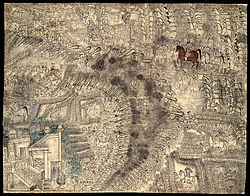
Back احمد شاہ درانی دیاں ہندوستان اُتے لشکری مہماں PNB پر هند د احمد شاه بابا لښکرکشي Pashto/Pushto احمد شاہ درانی کی ہندوستان پر لشکری مہمات Urdu
This article has multiple issues. Please help improve it or discuss these issues on the talk page. (Learn how and when to remove these messages)
|
The Indian Campaign of Ahmad Shah Durrani (1748–1767) was a series of invasions by the Afghan Empire led by the Emperor of the Afghan, Ahmad Shah Durrani, against the declining Mughal Empire, the Maratha Confederacy, Sikh Confederacy and numerous other Indian kingdoms. The primary basis of the invasions originated after the political independence of the Afghan Empire following the end of the Naderian Wars and persisted until the subsequent defeat of Ahmad Shah by the Sikh misls in 1767. The campaign is categorised into three wars: Afghan–Mughal War, Afghan–Maratha War, and Afghan–Sikh War and an array of local conflicts aimed at the subjugation of politically independent nations like Kalat, Sind, Kashmir, Lahore etc.
Ahmad Shah Durrani (also known as Ahmad Shah Abdali), the founder of the Durrani Empire, invaded Indian subcontinent a total of eight times between 1748 and 1767, following the collapse of Mughal Empire in the mid-18th century. His objectives were met through the raids (taking the wealth and destroying sacred places belonging to the Indians) and deepened the political crisis in India.[1][2][3][4]
- ^ Singh, Kulwant (15 July 2012). "Society - Raiding the raiders -Sikhs warriors of the 18th century adopted guerrilla tactics. They offered tough resistance to the invading Afghan armies of Nadir Shah and Ahmed Shah Abdali by looting them and freeing those enslaved by them". The Sunday Tribune - Spectrum (www.tribuneindia.com). Retrieved 4 December 2020.
- ^ Betts, Vanessa; Victoria McCulloch (2013). India: The North. Bath, UK: Footprint. p. 146. ISBN 978-1-907263-74-3. OCLC 881063949.
- ^ Bansal, Bobby Singh (2015). "Chapter 5 - North-West Frontier". Remnants of the Sikh empire: historical Sikh monuments in India and Pakistan. New Delhi: Hay House Publishers India. ISBN 978-93-84544-89-8. OCLC 934672669.
- ^ Tom Lansford, ed. (2017). Afghanistan at War: From the 18th-century Durrani Dynasty to the 21st Century. Santa Barbara, California: ABC-CLIO. p. 21. ISBN 978-1-59884-759-8. OCLC 952980822.




